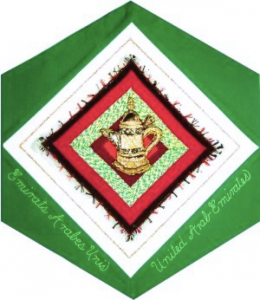United Arab Emirates

The Block
Multiple layers of luxurious golden fabrics, appliquéd by Shireen Kamran, create a Dallah, a traditional long-spouted coffee pot and symbol of Arab sociability and hospitality. Ghawa, or coffee, is an important element of the culture, and is served everywhere including at business meetings, in small shops, in offices and in the traditional coffeehouses which were once the main meeting places in the Gulf. Emiratis customarily offer the beverage to their guests––flavoured with cardamom or cloves and served in small handle-less cups––as a sign of welcome. The Dallah rests on a background of hand-woven cloth, which incorporates several traditional Bedouin colours. Weaving, called al-sadu, used for both decorative and practical purposes, is still a popular pastime amongst women. They produce such things as handbags, saddle-bags, shawls, cushion covers and rugs, using sheep’s wool, goat hair and camel hair.
Cultural Profile
The United Arab Emirates, commonly known as UAE, is a federation of seven sovereign states located on the southeastern coast of the Arabian Peninsula. The emirates, formerly known as the Trucial States, became independent in 1971 when the British withdrew from the Persian Gulf. Once a poor country, the discovery of oil in the 1950s brought rapid growth and modernization to the UAE, making it a nation with one of the world’s highest standards of living. However, because of this rapid growth in the economy, the existing population could not meet the demand for labour and outside workers were brought in. Today only about 20 percent of the inhabitants are native citizens; the remainder are expatriates predominantly from Asia. Oil remains a key industry, however transport and banking have also become increasingly important. In Dubai, tourism is especially important as people come to see the modern architecture, indoor ski hill or sprawling shopping centers. The traditional occupations of fishing and pearling are still practiced. Arabic is the official language, although English and Farsi are widely used.
In a society that has undergone rapid changes, the family remains the most important institution, providing security, advice and comfort. Courtesy and hospitality (both the giving and receiving of) are two of the most highly prized virtues in the culture, which is a blend of modern and traditional elements. Clothing styles combine Western and indigenous influences with most women wearing the black abaya and most men wearing the white dishdasha. This white costume must be clean at all times, and it is said that some men will own up to 50 dishdashas as they need to be changed often.
Oral traditions––developed from the nomadic Bedouin lifestyle––are a central part of the cultural heritage, as are songs and music. In the past, rhythmic chants were a way of easing the burden of work, and hudaa (Arabic singing) was a source of comfort for pearl fishermen who were away from home for long periods of time. Today dances, such as the ayyalah, the liwa and the noban are performed at almost all celebrations, often accompanied by such instruments as the tamboura and manior. Camels have long been the primary means of travel in the desert and camel-racing is a popular sport that maintains a link to the past. Falconry is another traditional pastime still practiced in the UAE, and it was here that the world’s first falcon hospital was established.
Traditional crafts of the UAE include the sadu weaving shown on the block as well as bobbin embroidery called talli to make decorative bands for clothes, sometime using metal threads. Palm fronds are used to create baskets, mats and various decorative items. Gold jewellery is especially prized by the Emiratis.
People have been coming to Canada from the United Arab Emirates since 1901, with the main groups arriving between 1961 and 1975. Many came as factory workers and labourers, settling in Ontario, Québec, the Maritime Provinces, Alberta and Saskatchewan.
Sponsor: Alicia Page Cassidy
